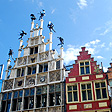FLANDERS
FIELDS IN "THE GREAT WAR"
WWI Monuments and Museums of Belgium
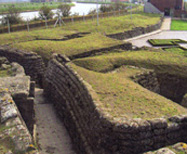 “In
Flanders Fields” became known in the years following
World War I to mean the hundreds of thousands of dead left behind in
the grassy
plains of Westhoek region of
central Belgium known to soldiers of England as Flanders
from 1914
to 1918. The red
poppies which sprouted from the soil upturned by the
digging of fresh graves
in makeshift cemeteries came to be recognized
as symbols of the sacrifice of soldiers. It
was
here
that
the world
first discovered the utter
brutality
and ultimate futility of trench warfare with the most deadly battles
of World War One. Up to half a million men would die in a battle
to gain less than 2 miles of ground under heavy shelling and futile
charges
on
entrenched positions. For war buffs and history tourists the area
of north west Belgium is dotted with a war memorials, monuments
and museums, from haunting
statues to cemeteries for English, French, Canadian, Austrian, French
and German dead, and trenches that have remained much as they were. The “War and Peace” project in Westhoek Belgium
has tied together the war sites for ease of touring and visiting
with
routes that can be followed by foot, car, or bicycle. The In
Flanders Fields Route with some of the most important cemeteries
and monuments of the WWI battlefields begins and ends in the town of Ypres.
“In
Flanders Fields” became known in the years following
World War I to mean the hundreds of thousands of dead left behind in
the grassy
plains of Westhoek region of
central Belgium known to soldiers of England as Flanders
from 1914
to 1918. The red
poppies which sprouted from the soil upturned by the
digging of fresh graves
in makeshift cemeteries came to be recognized
as symbols of the sacrifice of soldiers. It
was
here
that
the world
first discovered the utter
brutality
and ultimate futility of trench warfare with the most deadly battles
of World War One. Up to half a million men would die in a battle
to gain less than 2 miles of ground under heavy shelling and futile
charges
on
entrenched positions. For war buffs and history tourists the area
of north west Belgium is dotted with a war memorials, monuments
and museums, from haunting
statues to cemeteries for English, French, Canadian, Austrian, French
and German dead, and trenches that have remained much as they were. The “War and Peace” project in Westhoek Belgium
has tied together the war sites for ease of touring and visiting
with
routes that can be followed by foot, car, or bicycle. The In
Flanders Fields Route with some of the most important cemeteries
and monuments of the WWI battlefields begins and ends in the town of Ypres.
Ypres Salient
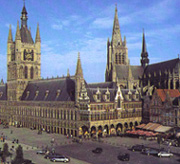 Ypres
(or Ieper) was known for manufacturing cloth in the middle ages and
had long been fought over
between the
French and English. But in 1914 German forces rolled across the plains
in the
first years of the war. The English commonwealth came to defend.
Ypres was almost completely reduced to stubby stone rubble by artillery,
almost
unbelievable to visit today as much of it has been rebuilt to a beautiful
grand town. The In Flanders Fields Museum shows
original films of the devastated town and the battle fields of “no-man's
land” of
the Ypres Salient, along
with letters and displays evoking the time. A special card allows
visitors to follow the stories of individual
real people.
Ypres
(or Ieper) was known for manufacturing cloth in the middle ages and
had long been fought over
between the
French and English. But in 1914 German forces rolled across the plains
in the
first years of the war. The English commonwealth came to defend.
Ypres was almost completely reduced to stubby stone rubble by artillery,
almost
unbelievable to visit today as much of it has been rebuilt to a beautiful
grand town. The In Flanders Fields Museum shows
original films of the devastated town and the battle fields of “no-man's
land” of
the Ypres Salient, along
with letters and displays evoking the time. A special card allows
visitors to follow the stories of individual
real people. 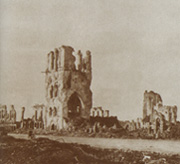 In connection with the museum,
the Yorkshire Trench, an original
dugout intended to defend the city has been restored by archeologist
to its wartime state, to experience what the trenches were like.
A series of information plaques give visitors a representation of
the trench warfare
experience, what war was like in the trenches as bombs exploded above
and machine gun bullets traced overhead. The Essex
Farm Cemetery is
located near the Canal Bank where the guns of the 1st Canada Artillery
Brigade
were placed
in 1915, and
from where Canadian Medical Officer John McCrae was inspired to
write a poem “In
Flanders Fields”, which
came to signify the bloody futility of the war, even though it had
3 brutal years left to go. The Documentation Center holds 6,000
books, topographic maps,
photos, newspapers and magazines about WWI. The exploration route
takes you past the German Military Cemetery at Langemark, the Canadian
Memorial
in Sint-Juliaan, Hill 62 and Kemmel Hill. Back in Ypres, the Menin
Gate is the most well known monument for the British Commonwealth
in Flanders in WW1.
It bears the names of over 50,000 soldiers reported missing in the
war. Every evening at 8pm a ceremony called “The Last Post” is
held at the stone arch when traffic stops and buglers play a memorial
salute.
In connection with the museum,
the Yorkshire Trench, an original
dugout intended to defend the city has been restored by archeologist
to its wartime state, to experience what the trenches were like.
A series of information plaques give visitors a representation of
the trench warfare
experience, what war was like in the trenches as bombs exploded above
and machine gun bullets traced overhead. The Essex
Farm Cemetery is
located near the Canal Bank where the guns of the 1st Canada Artillery
Brigade
were placed
in 1915, and
from where Canadian Medical Officer John McCrae was inspired to
write a poem “In
Flanders Fields”, which
came to signify the bloody futility of the war, even though it had
3 brutal years left to go. The Documentation Center holds 6,000
books, topographic maps,
photos, newspapers and magazines about WWI. The exploration route
takes you past the German Military Cemetery at Langemark, the Canadian
Memorial
in Sint-Juliaan, Hill 62 and Kemmel Hill. Back in Ypres, the Menin
Gate is the most well known monument for the British Commonwealth
in Flanders in WW1.
It bears the names of over 50,000 soldiers reported missing in the
war. Every evening at 8pm a ceremony called “The Last Post” is
held at the stone arch when traffic stops and buglers play a memorial
salute.
The Yzer Front Route leads through the polder lands
between the towns of Nieuwport and Diksmuide.
The “Trench of Death” and “Our
Lady’s Corner” along the Yzer River are places to find
war relics and another restored trench museum memorials. The “Town
Link” is
a series of buttons in the sidewalks marking sites through the town
of Diksmuide with tales and images of the town's destruction and
rebuilding. The King Albert I Monument is at the
junction of the canals in Nieuwport.
Poperinge & Passchaendale
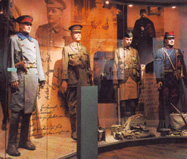 Other
towns to visit are Mesen where the Irish Peace
Park and Peace Tower, honoring Irish dead, the Messines Ridge
Memorial at the British Cemetery,
the New Zealand Memorial commemorating New Zealand and Australian
soldiers and a small history Museum in town and a youth hostel at the
Peace School. Poperinge, nicknamed “pops” in
the war has the Talbot House where a popular club for soldiers was established
by Reverend “Tubby” Clayton.
The club was enjoyed by over a half million soldiers between 1915
and 1918. The upstairs chapel remains as it was. You can actually
stay in
the Talbot House for some authentic experience.
At the town hall is the Death Cell where condemned deserters were
held before being
shot at dawn
at the execution pole in the courtyard. I imagine it was preferable
to spend the night at the Talbot House than in the death cell. In
Zonnebeke
is the Memorial Museum of Passchendaele (remembered
for the gruesome battle of “Passiondale”). The museum,
located in the the town castle has a walk-through German
trench and a British
dug-out headquarters
with displays of uniforms and other historical objects and dioramas.
The Tyne Cot Cemetery nearby is the
largest burial ground of
British Commonwealth soldiers in the world (see Passchendaele
1917 & Tyne Cot).
Other
towns to visit are Mesen where the Irish Peace
Park and Peace Tower, honoring Irish dead, the Messines Ridge
Memorial at the British Cemetery,
the New Zealand Memorial commemorating New Zealand and Australian
soldiers and a small history Museum in town and a youth hostel at the
Peace School. Poperinge, nicknamed “pops” in
the war has the Talbot House where a popular club for soldiers was established
by Reverend “Tubby” Clayton.
The club was enjoyed by over a half million soldiers between 1915
and 1918. The upstairs chapel remains as it was. You can actually
stay in
the Talbot House for some authentic experience.
At the town hall is the Death Cell where condemned deserters were
held before being
shot at dawn
at the execution pole in the courtyard. I imagine it was preferable
to spend the night at the Talbot House than in the death cell. In
Zonnebeke
is the Memorial Museum of Passchendaele (remembered
for the gruesome battle of “Passiondale”). The museum,
located in the the town castle has a walk-through German
trench and a British
dug-out headquarters
with displays of uniforms and other historical objects and dioramas.
The Tyne Cot Cemetery nearby is the
largest burial ground of
British Commonwealth soldiers in the world (see Passchendaele
1917 & Tyne Cot).
American Cemetery
The only American cemetery in Belgium from WWI is located in Waregem,
25 miles from Ypres. America came into the “war to end all
wars” in
1918 for the last offensives. The Flanders Field American
Cemetery at
Waregam is the smallest in Europe.
But it wasn’t only allied solders who spilled blood in Flanders
Fields, there are a number of German cemeteries as well, usually
much more stark and forlorn than the ultimate “victors”,
though its hard to say that anyone actually “won” this
war.
For other war cemeteries in Europe - in Belgium Ardennes
Battle of the Bulge WWII Sites - and German
Cemetery Recogne in
France The
Somme and Belleu
Wood-Marne.
It is possible to find the location of the war dead on the web.
For Great Britain and Commonwealth soldiers in all wars www.cwgc.org for
German soldiers www.volksbund.de and
American War Cemeteries www.abmc.gov. © Bargain
Travel Europe
Find best hotel and travel deals in Flanders on TripAdvisor
Web
Info
Flanders Tourism
World War I in Westhoek
Talbot House
London to Brussels Eurostar
These articles are copyrighted and the sole property of Bargain Travel Europe and WLPV, LLC. and may not be copied or reprinted without permission. Photos Courtesy Westhoek Belgium Tourism
SEE ALSO:
BRITAIN’S UNKOWN WARRIOR REMEMBRANCE TOUR
ST
GEORGE’S MEMORIAL CHURCH
EUROSTAR
LONDON / PARIS
GODEFROID'S
CRUSADER'S CASTLE BOUILLON
ORVAL
MONASTERY BELGIAN TRAPPIST BEER

